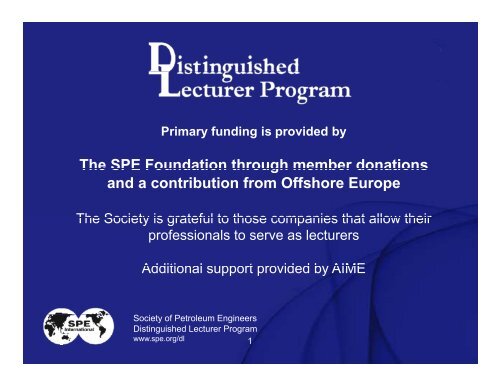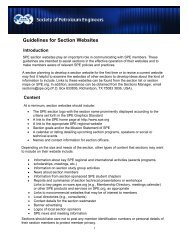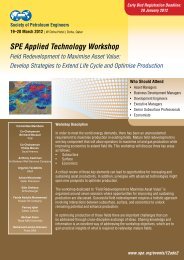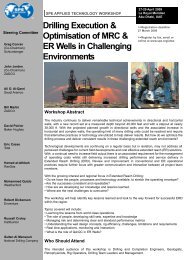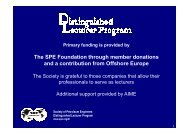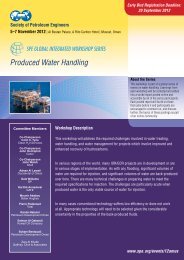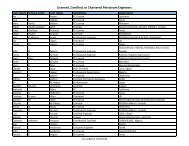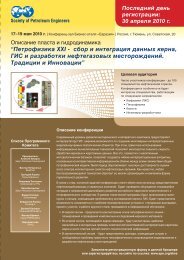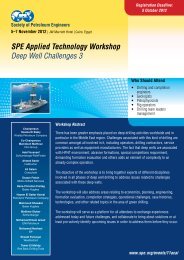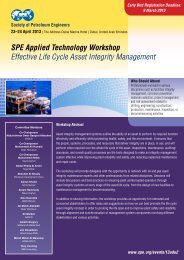How Hydraulic Fracturing has Changed Sand Control - Society of ...
How Hydraulic Fracturing has Changed Sand Control - Society of ...
How Hydraulic Fracturing has Changed Sand Control - Society of ...
You also want an ePaper? Increase the reach of your titles
YUMPU automatically turns print PDFs into web optimized ePapers that Google loves.
Primary funding is provided by<br />
The SPE Foundation through member donations<br />
and a contribution from Offshore Europe<br />
The <strong>Society</strong> is grateful to those companies that allow their<br />
pr<strong>of</strong>essionals to serve as lecturers<br />
Additional support provided by AIME<br />
<strong>Society</strong> <strong>of</strong> Petroleum Engineers<br />
Distinguished Lecturer Program<br />
www.spe.org/dl 1
<strong>Fracturing</strong> for <strong>Sand</strong> <strong>Control</strong>: <strong>How</strong><br />
<strong>Hydraulic</strong> <strong>Fracturing</strong> <strong>has</strong> <strong>Changed</strong><br />
<strong>Sand</strong> <strong>Control</strong><br />
Raymond Tibbles<br />
Schlumberger Oilfield Services<br />
<strong>Society</strong> <strong>of</strong> Petroleum Engineers<br />
Distinguished Lecturer Program<br />
www.spe.org/dl<br />
2
<strong>Sand</strong> <strong>Control</strong> Goal<br />
• The big three goals <strong>of</strong> <strong>Sand</strong> <strong>Control</strong><br />
– Stop/minimize production <strong>of</strong> formation solids<br />
– Maximize i production rate/ minimizing<br />
i i i<br />
impairment<br />
– Maintain performance over well life<br />
• Has fracturing improved our ability to<br />
delivered d these goals. And can it continue<br />
to do so in the future?<br />
3
Main SC Completion Types<br />
• Non Frac<br />
– Cased Hole Gravel Pack (CHGP)<br />
– Open Hole Gravel Pack (OHGP)<br />
– Stand Alone Screen (SAS)<br />
– Formation Consolidation<br />
• <strong>Fracturing</strong><br />
– Screenless Frac Pack<br />
– High Rate Water Pack (HRWP)<br />
– Frac Pack<br />
– Frac followed by Expandable Screen<br />
4
Screenless Frac Pack Completions<br />
Indirect Vertical<br />
Fracture<br />
Indirect Vertical<br />
Fracture +<br />
Intelligent<br />
Perforating<br />
Weak<br />
Optimized Perforating<br />
and <strong>Fracturing</strong><br />
W or WO Resin<br />
Consolidation<br />
Competent<br />
Propped<br />
Fracture<br />
Weak<br />
Layer<br />
Competent<br />
Layer<br />
Propped<br />
Fracture<br />
Weak<br />
Weak<br />
Competent<br />
Competent<br />
Piltun-Asstokhsky<br />
Sakhalin<br />
SPE 68638<br />
Jauf Reservoir<br />
Saudi Arabia<br />
SPE 73724<br />
Main Pass 41<br />
SPE 107440<br />
Yegua Formation<br />
SPE 96289 5
HRWP Completions<br />
• Application<br />
– Wells where height<br />
growth is a concern<br />
– Equipment for frac<br />
pack is not available<br />
• Multiple pad/slurry<br />
stages create short<br />
fractures.<br />
<strong>Sand</strong>stone<br />
6
Frac Pack Completions<br />
• Application: Most if not all<br />
cased hole completions<br />
• Single Stage <strong>of</strong> fracturing<br />
fluid (pad) followed by<br />
multiple slurry stages<br />
(ramped prop conc.) with<br />
<strong>Sand</strong>stone<br />
tip screenout design.<br />
• Key design requirement is<br />
a wide highly conductive<br />
fracture.<br />
7
Does Exceeding Frac Pressure<br />
Make a Difference?<br />
8
<strong>Fracturing</strong> Improves Reliability<br />
9<br />
9<br />
8<br />
7<br />
6<br />
5<br />
4<br />
3<br />
2<br />
1<br />
0<br />
Failures/Well Life<br />
(failure<br />
es/year x 100)<br />
Data courtesy <strong>of</strong> George King (June 2003)
<strong>Fracturing</strong> Improves Production<br />
o<br />
ability<br />
Cum mulativ ve Prob<br />
120%<br />
100%<br />
80%<br />
60%<br />
Frac pack<br />
Gravel Pack<br />
HRWP<br />
40%<br />
20%<br />
0%<br />
0% 50% 100% 150% 200%<br />
Flow Efficiency<br />
Reference # Wells<br />
IPTC 11166 4<br />
SPE 103779 8<br />
SPE 110359 2<br />
SPE 111455 1<br />
SPE 30093 17<br />
SPE 30115 7<br />
SPE 30470 36<br />
SPE 31475 17<br />
SPE 36423 12<br />
SPE 36459 8<br />
SPE 38592 10<br />
SPE 39478 10<br />
SPE 63107 4<br />
SPE 68753 25<br />
SPE 73722 35<br />
SPE 77434 6<br />
SPE 78322 4<br />
SPE 84259 10<br />
SPE 86530 1<br />
SPE 87199 31<br />
SPE 96307 7<br />
Grand Total 255<br />
10
5000 bopd<br />
Chance to get<br />
3000 bopd?<br />
24.8% max 6600 bopd<br />
50.2% max <strong>of</strong> 8400 bopd<br />
37.3% max <strong>of</strong> 6600 bopd<br />
11
Causes <strong>of</strong> Low Productivity in<br />
Gravel Packs<br />
• Low gravel permeability in the perforation<br />
tunnels.<br />
– Crushed zone;<br />
– Gravel/sand mixing;<br />
– Post-perforating ti fluid loss pills<br />
• Fines migration over time<br />
12
Reality <strong>of</strong> Packed Perforations<br />
Ideal Perforations<br />
The Cold Hard Truth<br />
A<br />
B<br />
C<br />
A<br />
B C<br />
Region A Region B Region C<br />
13<br />
Region A Region B Region C
Fines Migration in a Gravel Pack<br />
(data supplied by NS Operator)<br />
/psi)<br />
PI (blpd<br />
8<br />
14<br />
7<br />
6<br />
5<br />
4<br />
3<br />
2 PI (blpd/psi)<br />
1<br />
Skin Factor<br />
0<br />
0 200 400 600<br />
12<br />
10<br />
8<br />
6<br />
4<br />
2<br />
0<br />
Skin<br />
Time (days)<br />
50% <strong>of</strong> the PI is lost in the first year.<br />
(26 lb/ft gravel) 14
What Does <strong>Fracturing</strong> Do To Help?<br />
• Ensures that the critical area <strong>of</strong> the<br />
perforation tunnel is full <strong>of</strong> clean gravel<br />
free <strong>of</strong> formation sand or debris High<br />
perm gravel in perfs<br />
• Increases the reservoir contact t area.<br />
– Decreases fluid velocity in the reservoir <br />
Reduced tendency for fines migration<br />
15
<strong>Fracturing</strong> Puts More Gravel<br />
Through h Perforations<br />
• Generally accepted industry value for<br />
gravel packing perforations: 25 lb/ft <strong>of</strong><br />
perforations.<br />
• One NS Operator HRWP Avg: 112 lb/ft<br />
<strong>of</strong> perforations.<br />
• Same NS Operator Frac Pack Avg: 516<br />
lb/ft <strong>of</strong> perforations<br />
16
<strong>Fracturing</strong> Increases Reservoir<br />
Contact<br />
Gravel Pack 3 ft Half 30 ft Half<br />
Length Frac Length Frac<br />
200 ft 2 1100 ft 2<br />
11000 ft 2<br />
82% Reduction<br />
In <strong>Sand</strong> Face<br />
98% Reduction<br />
In <strong>Sand</strong> Face<br />
H = 92 feet<br />
Velocity<br />
Velocity<br />
Rw = 8.5 inch<br />
Perf diameter = 0.83 inch<br />
Shot density = 21 spf 17
More Area Means No Fines Migration<br />
Form Fluid Ve elocity (ft t/sec)<br />
0.00050<br />
0.00040<br />
0.00030<br />
0.00020<br />
0.0001000010<br />
0.00000<br />
GP<br />
HRWP<br />
Frac Pack<br />
Fines<br />
0 2000 4000 6000 8000 10000<br />
Flow Rate (blpd)<br />
Every formation <strong>has</strong> a different critical fines movement<br />
• Every formation <strong>has</strong> a different critical fines movement<br />
velocity. This is one case where it was 0.00029 ft/sec 18
Impact <strong>of</strong> Gravel Volume<br />
(oil well case in a low bhp reservoir)<br />
I (blpd/ps i/ft)<br />
Norm malized P<br />
0.35<br />
0.3<br />
0.25<br />
02 0.2<br />
0.15<br />
0.1<br />
0.05<br />
0<br />
HRWP<br />
Frac Pack<br />
Frac & Pack<br />
Linear (Frac Pack)<br />
0.0 500.0 1000.0 1500.0 2000.0<br />
lbs gravel placed/ft <strong>of</strong> perforations<br />
For this example there appears to be a link<br />
between gravel mass and Normalized PI. This is<br />
not always the case.<br />
19
Better Understanding is Improving Results<br />
(SPE 71658 Morales et al)<br />
• Near wellbore temperature cool down from<br />
injection <strong>of</strong> pre-frac and frac-pack fluids.<br />
( OF )<br />
BHT<br />
300<br />
280<br />
260<br />
240<br />
220<br />
200<br />
180<br />
160<br />
140<br />
120<br />
Acid<br />
1 st Calib 2 nd Calib<br />
190 o F<br />
12000<br />
10000<br />
8000<br />
6000<br />
4000<br />
2000<br />
0<br />
BHP<br />
(psi)<br />
1900 2000 2100 2200 2300<br />
Time (min)<br />
20
Temperature cool down inside the fracture<br />
(after Sinclair)<br />
TD<br />
1<br />
0.8<br />
0.6<br />
0.4<br />
0.2<br />
0<br />
T<br />
D<br />
=<br />
T<br />
T<br />
r<br />
−T<br />
i<br />
−T<br />
i<br />
90%<br />
70%<br />
50% 30%<br />
20%<br />
10%<br />
5%<br />
0 0.2 0.4 0.6 0.8 1<br />
X/L<br />
21
New Techniques – Fluid Selection<br />
• Cool-Down Based Fluid<br />
Selection<br />
– Improved success<br />
rate <strong>of</strong> achieving Tip<br />
Screenout (TSO)<br />
– Allows optimization<br />
p y<br />
breaker loading<br />
300<br />
280<br />
260<br />
240<br />
rate <strong>of</strong> achieving Tip 220<br />
BHT ( OF )<br />
200<br />
180<br />
160<br />
<strong>of</strong> polymer and 140<br />
Acid<br />
1 st Calib<br />
190 o F<br />
2 nd Calib<br />
120<br />
0<br />
1900 2000 2100 2200 2300<br />
Time (min)<br />
12000<br />
10000<br />
8000<br />
6000<br />
4000<br />
2000<br />
BH HP (psi)<br />
Rate (M MMCFD)<br />
70<br />
60<br />
50<br />
40<br />
30<br />
20<br />
10<br />
0<br />
*Tubing Limited<br />
Conventional<br />
Cool Down Technique<br />
A1 A2 A3 A4 B1 B2 B3*<br />
Well<br />
Bottom hole temperature pr<strong>of</strong>ile during treatment –<br />
Fluid Designed at 190 O F<br />
22
Facing Up To The Challenges?<br />
• Unwanted adjacent water and gas<br />
• Brown fields/depleted reservoirs<br />
• High permeability formations<br />
• Thicker zones ( > 500 ft) w/ Multi-lobes<br />
lobes<br />
• Emerging area deep water.<br />
• UltraDeep water<br />
– Deeper<br />
– Absence <strong>of</strong> stress barriers<br />
– Higher Pressure<br />
– Higher Temperature<br />
23
Is <strong>Fracturing</strong> Out <strong>of</strong> Zone Really a Problem?<br />
• S<strong>of</strong>t rocks and standard design<br />
limits height growth.<br />
– Low Young’s Modulus<br />
– TSO inhibits growth<br />
– Low efficiency frac fluids.<br />
• Proper precautions minimize even<br />
severe risk.<br />
(SPE 73776 Guichard et al.)<br />
• SPE 85259 deals with one <strong>of</strong> the<br />
most difficult cases.<br />
24
Height <strong>Control</strong> in Unfavorable Case<br />
Perforate the<br />
whole zone<br />
Frac out <strong>of</strong><br />
zone<br />
Limit the<br />
perforation<br />
height and<br />
control the<br />
fracture height<br />
SPE 95987<br />
8 ft shale with water below<br />
Small frac pad<br />
Small slurry stage<br />
Fracture did not break through the shale<br />
S f Tracer Log<br />
25
Fracs Deliver in Brown Fields<br />
• Well Data<br />
– Casing: 5 inch<br />
– Deviation: 33 deg<br />
– KH: 5100 md-ft<br />
– Depth:7550 ft<br />
– BHST: 200 F<br />
– Perforation:<br />
• Density: 24 spf<br />
• Treatment Data<br />
– Fluid: 30 lb borate xlink<br />
– Gravel: 16/20 LWC<br />
– Placed: 1243 lbs/ft<br />
• Results<br />
– Produced d via ESP<br />
– Post FP PI/Pre FP PI: 1.04<br />
– Post FP Skin: -0.5<br />
26
High Permeability Concerns<br />
• SPE39475: limit frac packs<br />
– Oil Kf < 900 md<br />
– Gas Kf < 150 md.<br />
– OH GP for the highest rate wells<br />
• SPE 111455: Frac Packs are the best<br />
solution for high permeability formation<br />
if the wellbore is properly aligned with<br />
the fracture.<br />
27
Cased Hole Frac-Packs<br />
Openhole Horizontal<br />
or<br />
Openhole Frac-Pack<br />
or<br />
Openhole GP Above<br />
Frac Pressure?<br />
Transmisibility (kh) 1000 mD-ft<br />
Oilfield Review, Summer 2001 (BP, Chevron, EniAgip, M-I,<br />
Repsol-YPF, Schlumberger, Shell, Stone Energy, Texaco)<br />
28
High Rate Limitions<br />
– Pressure Loss in Perforation tunnel (Forchheimer)<br />
0.888 L μ<br />
13<br />
Δ P= Q + 9.1×<br />
10 βLρ ⎡Q⎤<br />
KA<br />
⎢<br />
⎣A⎥<br />
⎦<br />
Where:<br />
A = Perf Cross-Sectional Area (Ft2)<br />
B = Inertia Coefficient (Ft-1)<br />
∆<br />
∆P = Differential Pressure (psi)<br />
K = Permeability (Darcies)<br />
L = Length Of Perforation (ft)<br />
μ = Viscosity (Centipoise)<br />
Q = Flow Rate (B/D)<br />
ρ = Density Of Fluid (lb/Ft3)<br />
2<br />
90º 10º 0º
High Rate Gas Skin (SPE 68753)<br />
• Avg Damage Skin<br />
Damage<br />
Skin<br />
400<br />
350<br />
300<br />
(Deviation and Partial completion 250<br />
skins removed)<br />
200<br />
– All Cases<br />
• FP = 18<br />
• HRWP = 55*<br />
– Less than 1 Darcy<br />
•FP = 18<br />
• HRWP = 31*<br />
Rat te Depende nt Skin Coe eff<br />
(1/MSC CFD)<br />
150<br />
100<br />
*Neglected 800 Skin 0.001<br />
50<br />
0<br />
1<br />
0.1<br />
0.01<br />
0.0001<br />
Sd HRWP<br />
Sd FP<br />
0 1000 2000 3000 4000 5000<br />
Permeability (mD)<br />
D HRWP<br />
D Frac Pack<br />
0 1000 2000 3000 4000 30 5000<br />
Permeability (mD)
Frac Packs Can Deliver High<br />
Production Rate Completions<br />
• Gas<br />
– SPE106854 BP Trinidad and Tobago:<br />
• Oil<br />
• FP 75-150 MM/day (100 – 600 mD)<br />
• OH GP: 72 – 320 MM/day (100 – 1700 mD)<br />
– SPE 78322 Total Angola:<br />
• FP 15,000 – 25,000 bopd (800-2700 mD)<br />
– SPE 84415 ConocoPhillips USA:<br />
• FP two wells 22,400 bopd/well<br />
– FP Non documented GOM – 40,000 bopd<br />
– SPE 48977 BP North Sea:<br />
• OH Horizontal – 30,000 bopd<br />
31
Other Options in Emerging Deep<br />
• Rig Based <strong>Fracturing</strong><br />
Water<br />
– Dependent on available deck space<br />
– Inhibits many rig operations<br />
– Limited rates and volumes<br />
• Supply Boat Based <strong>Fracturing</strong><br />
– Limited Rates and Volume but more flexibility<br />
– Minimum impact on rig operations<br />
32
Modular Supply Vessel Operation<br />
(900m2 deck area)<br />
• 650,000 lbm <strong>of</strong> proppant<br />
• 10,000000 psi MWP<br />
• 40 BPM max rate<br />
• 9,000 HHP<br />
• 200,000 gals batch mixed gel<br />
stored below deck<br />
• Connected to Rig via 4” 10,000 psi<br />
C<strong>of</strong>lexip hose c/w EQD on TR12<br />
Reel<br />
33
Lower Tertiary - Miocene and Paleogene<br />
Water Depth 4 – 10,000 ft<br />
> 1500 ft<br />
TVD 15,000 ft – 33, 000 ft<br />
BHP 13 ppg – 15.2 ppg<br />
BHT 160 OF – 310 ºF<br />
34
Challenges and Solutions<br />
• Temperature: No problem we have fluids<br />
to handle 400+ degrees F.<br />
• High Pressure:<br />
– 20000 psi treating equipment - does the market<br />
justify the cost?<br />
– High density frac fluids to help but there are<br />
limits. SPE 116007 reported surface pressure<br />
reductions from 22 to 39% with an average<br />
surface pressure reduction <strong>of</strong> 34%<br />
Δp<br />
L<br />
=<br />
2fρV<br />
D<br />
2<br />
• Temperature and Pressure: Still struggling<br />
to provide a high density fluid that can<br />
work at 325+ ºF<br />
35
Facing Up To The Challenges?<br />
• Unwanted adjacent water and gas<br />
• Brown fields/depleted reservoirs<br />
• High permeability formation<br />
–Gas<br />
–Oil<br />
• Emerging Area Deep Water<br />
• UltraDeep Water Plays<br />
– Deeper<br />
– Higher Pressure<br />
– Higher Temperature<br />
36
Conclusions<br />
• <strong>Sand</strong> <strong>Control</strong> fracturing completions have clearly<br />
shown increased productivity in many different<br />
environments.<br />
• Many <strong>of</strong> the challenges to using fracturing have already<br />
been overcome<br />
– Unwanted water/gas<br />
– High permeability formations<br />
– Application in developing areas<br />
• Some challenges still require work or may not be<br />
applicable<br />
– Ultra high permeability (especially in gas wells)<br />
– High pressure especially in combination with temperature<br />
above 325 F<br />
37
Questions?<br />
38
Your Feedback is Important<br />
Enter your section in the DL Evaluation Contest by<br />
completing the evaluation form for this presentation or<br />
go online at:<br />
http://www.spe.org/events/dl/dl_evaluation_contest.php<br />
<strong>Society</strong> <strong>of</strong> Petroleum Engineers<br />
Distinguished Lecturer Program<br />
www.spe.org/dl 39


